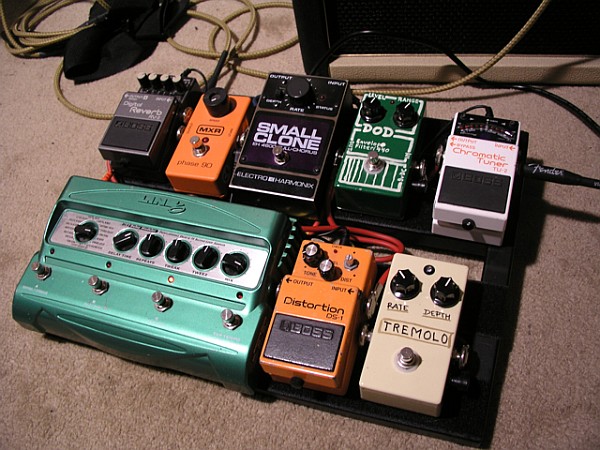Almost since the birth of amplified guitars in the early 1930s, players looked for ways to enhance the sound of their electric guitars. A huge variety of guitar effects have emerged from their experiments. These include rack-mounted effects, effects built into amplifiers, and pedal effects. While rack-mounted and built-in effects are separate topics, this article focuses on stomp boxes, which are foot-switchable pedal effects designed for use during live performance.
Some guitarists design or modify their own pedals. Others use a combination of off-the-shelf effects. Kurt Cobain stomped on Electro-Harmonix Big Muff and ProCo Rat pedals to create his classic loud-soft-loud, “Nevermind”-era sounds. John Mayer kicked off his 2003 hit, “Bigger Than My Body,” with see-sawing, arpeggiated sounds from his Roger Linn AdrenaLinn III pedal. There are hundreds, if not thousands, of different stomp boxes. Although there’s a certain amount of gray area and overlap, pedal effects can all be divided into four general categories:
- Pedals that boost, compress or distort a signal
- Pedals that modulate a signal
- Echo and delay effects
- Everything else: filter, modeling and multi effects
Before diving more deeply into each category, let’s take a quick look at the history of guitar effects.
History of Guitar Effects
The first amplified guitars appeared during the swing era in the early 1930s. Back then, big bands ruled the day, and horn players were the stars. Naturally, guitarists wanted to grab some of those solos for themselves, but the natural sound of early amplified guitars was thin, reedy and thoroughly anticlimactic.
It’s no surprise that guitarists quickly began looking for ways to pump up their sound. The very first guitar effects were built into instruments themselves. In the 1930s, Rickenbacker made a clunky Vibrola Spanish guitar with motorized pulleys that jiggled the bridge to create a vibrato effect. In the 1940s, DeArmond manufactured the world’s first standalone effect, a type of tremolo. Many guitarists looked for a way to reproduce the natural reverb and echo they enjoyed during soundchecks in empty halls. Guitarist Duane Eddy outfitted a 500-gallon metal water tank with a speaker at one end and a microphone at the other to create an artificial echo chamber for recording. However, there was no way he could have used such a contraption on stage [source: Hunter].
By the late 1950s, many amplifiers featured built-in tremolo, vibrato, echo and reverb effects; guitarists like Chet Atkins, Luther Perkins and Roy Orbison used these to produce the now-classic rock ‘n’ roll, “slapback” echo sound on stage. In the early 1960s, tape-based echo units, such as the Watkins Copicat, heavily influenced the sound of British beat rock [source: Hunter].
Early standalone guitar effects were powered with vacuum tubes. They were bulky, expensive, fragile and not very practical for live performance. Then, in the early 1960s, the transistor became widely available. For the first time, engineers were able to create affordable, portable standalone effects, such as the Uni-Vibe Jimi Hendrix used on his song “Machine Gun.” By the late 1970s, manufacture of affordable, solid-state effects had exploded, creating a whole new gear market that continues to thrive today.
Let’s take a look at each major type of effects pedal. First up, we’ll explore pedals that affect dynamics.
For more Details: How Guitar Pedals Work

